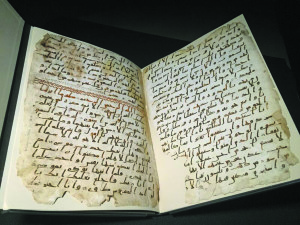University of Birmingham: A Qur’an manuscript held by the University of Birmingham has been placed among the oldest in the world, thanks to modern scientific methods. Radiocarbon analysis has dated the parchment on which the text is written to the period between AD 568 and 645 with 95.4% accuracy. The test was carried out in a laboratory at the University of Oxford. The result places the leaves close to the time of Prophet Muhammad (Pbuh), who is generally thought to have lived between AD 570 and 632.
Susan Worrall, Director of Special Collections (Cadbury Research Library), at the University of Birmingham, said: ‘The radiocarbon dating has delivered an exciting result, which contributes significantly to our understanding of the earliest written copies of the Qur’an. We are thrilled that such an important historical document is here in Birmingham, the most culturally diverse city in the UK.’
The Qur’an manuscript is part of the University’s Mingana Collection of Middle Eastern manuscripts, held in the Cadbury Research Library. Funded by Quaker philanthropist Edward Cadbury, the collection was acquired to raise the status of Birmingham as an intellectual centre for religious studies and attract prominent theological scholars.
Consisting of two parchment leaves, the Qur’an manuscript contains parts of Suras (chapters) 18 to 20, written with ink in an early form of Arabic script known as Hijazi. Susan Worrall said: ‘By separating the two leaves and analysing the parchment, we have brought to light an amazing find within the Mingana Collection.’
Dr Alba Fedeli, who studied the leaves as part of her PhD research, said: ‘The two leaves, which were radiocarbon dated to the early part of the seventh century, come from the same codex as a manuscript kept in the Bibliothèque Nationale de France in Paris.’
Explaining the context and significance of the discovery, Professor David Thomas, Professor of Christianity and Islam and Nadir Dinshaw Professor of Interreligious Relations at the University of Birmingham, said: ‘The radiocarbon dating of the Birmingham Qur’an folios has yielded a startling result and reveals one of the most surprising secrets of the University’s collections. They could well take us back to within a few years of the actual founding of Islam.
‘The tests carried out on the parchment of the Birmingham folios yield the strong probability that the animal from which it was taken was alive during the lifetime of Prophet Muhammad or shortly afterwards. This means that the parts of the Qur’an that are written on this parchment can, with a degree of confidence, be dated to less than two decades after Muhammad’s death. Dr Muhammad Isa Waley, Lead Curator for Persian and Turkish Manuscripts at the British Library, said: ‘This is indeed an exciting discovery. We know now that these two folios, in a beautiful and surprisingly legible Hijazi hand, almost certainly date from the time of the first three Caliphs.
[Photos: Qur’an Manuscript. Photo by Cadbury Research Library, University of Birmingham]
(www.muslimnews.com)
AUTHOR: Islamic Voice
Islamic Voice is a monthly Islamic magazine published in Bangalore. It is the largest English language Muslim publication in India. It is a comprehensive magazine, places a relatively high emphasis on social issues and strives to have a broad appeal. Since 1987, Islamic Voice has covered its fascinating namesake without fear or favour, with insight, accuracy, thoroughness and a well rounded perspective on a variety of subjects - be it the economy, politics, lifestyle, the arts, entertainment, travel, science, technology or health. That's why Islamic Voice is the country's most widely read publication, a position it has held for more than a decade. And that's why it makes sense to subscribe to Islamic Voice.
We represents all Muslim sects and shades of thought from all over India. We focus on "our" triumphs which, mostly, go unreported as well as constructively addresses our failures and shortcomings.
Editor-in-Chief: A.W. Sadatullah Khan
Genre: Current Affairs associated with Muslims
Subjects Covered:
Human Rights I Analysis I Special Reports I Issues I Book Reviews I National I International I Newsmakers I Community News I Islamic Perspectives I Classifieds I Opinions
Focus articles on:
Education and Children I Inter-faith Relations I Matrimony I Muslim economy I Muslim Perspective I The Muslim world I Society I Travel I The Western viewpoint I Women in Islam
Special focus on Faith and Law:
Fiqh I Hadith I Quran


COMMENTS